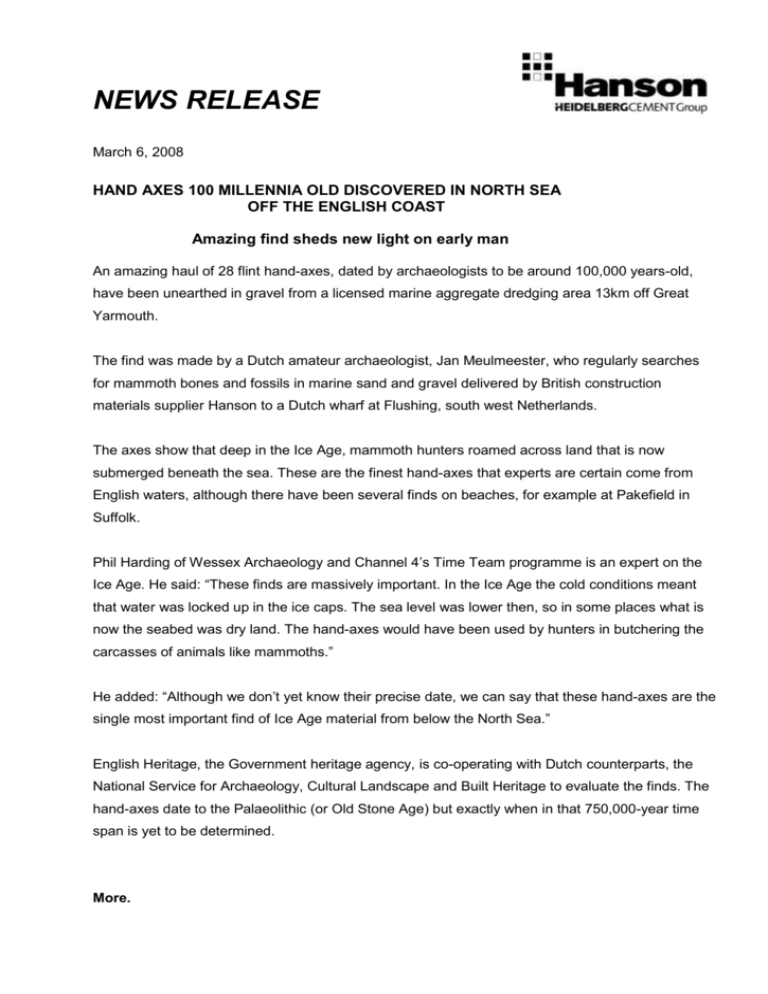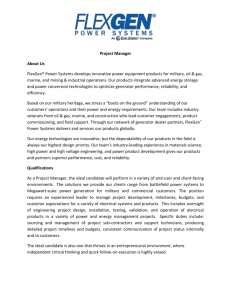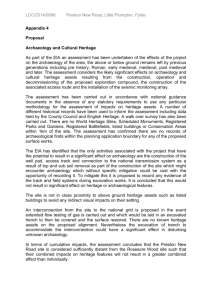NEWS RELEASE - Virtual Quarry
advertisement

NEWS RELEASE March 6, 2008 HAND AXES 100 MILLENNIA OLD DISCOVERED IN NORTH SEA OFF THE ENGLISH COAST Amazing find sheds new light on early man An amazing haul of 28 flint hand-axes, dated by archaeologists to be around 100,000 years-old, have been unearthed in gravel from a licensed marine aggregate dredging area 13km off Great Yarmouth. The find was made by a Dutch amateur archaeologist, Jan Meulmeester, who regularly searches for mammoth bones and fossils in marine sand and gravel delivered by British construction materials supplier Hanson to a Dutch wharf at Flushing, south west Netherlands. The axes show that deep in the Ice Age, mammoth hunters roamed across land that is now submerged beneath the sea. These are the finest hand-axes that experts are certain come from English waters, although there have been several finds on beaches, for example at Pakefield in Suffolk. Phil Harding of Wessex Archaeology and Channel 4’s Time Team programme is an expert on the Ice Age. He said: “These finds are massively important. In the Ice Age the cold conditions meant that water was locked up in the ice caps. The sea level was lower then, so in some places what is now the seabed was dry land. The hand-axes would have been used by hunters in butchering the carcasses of animals like mammoths.” He added: “Although we don’t yet know their precise date, we can say that these hand-axes are the single most important find of Ice Age material from below the North Sea.” English Heritage, the Government heritage agency, is co-operating with Dutch counterparts, the National Service for Archaeology, Cultural Landscape and Built Heritage to evaluate the finds. The hand-axes date to the Palaeolithic (or Old Stone Age) but exactly when in that 750,000-year time span is yet to be determined. More. 2. While the hand-axes were discovered in Holland, the gravel came from a licensed marine dredging area in English waters known as Area 240 – some 13km off Great Yarmouth lying in water depths of about 25m. Bones and teeth, some of which may be from mammoths, were also recovered along with the axes. Ian Oxley, Head of Maritime Archaeology at English Heritage, said: “These are exciting finds which help us gain a greater understanding of The North Sea at a time when it was land. We know people were living out there before Britain became an island, but sites actually proving this are rare.” Ian Selby, Hanson’s Marine Operations and Resources Director, added: “The hand-axes were collected over a three-month period and this remarkable discovery only came to light in February when Mr Meulmeester, realising their importance, informed the wharf owners. As we manage our dredging very carefully, we were quickly able to identify the area where the finds came from. As part of our industry’s protocol with English Heritage, we have now moved dredging to another part of the seabed.” The reporting of the hand-axes demonstrates the level of co-operation that exists between the dredging industry, through its trade association, The British Marine Aggregate Producers Association, and English Heritage. The protocol, signed in 2005, aims to protect archaeological remains discovered in English waters as a result of marine sand and gravel extraction. Ends. For more information contact David Harding of Hardingpr on 01686 640630/ 07967 655379 1. The reporting protocol for archaeological finds was an industry led initiative to prevent finds such as these going unreported. The potential for discovering finds has always been known to exist within dredging areas. The industry with consultants Wessex Archaeology and English Heritage established a mechanism through which any finds could be reported and assessed. The Guidance notes produced on behalf of English Heritage and BMAPA, can be viewed at: http://www.wessexarch.co.uk/projects/marine/bmapa/index.html 2. Hanson is one of the world’s largest suppliers of heavy building materials to the construction industry and is part of the HeidelbergCement Group, which employs 70,000 people across five continents. HeidelbergCement is the global leader in aggregates and has leading positions in cement, concrete and heavy building products. Hanson’s marine aggregate dredging business is the largest in Europe, delivering to 20 wharves around the UK and in Holland, Belgium and France. 3. The British Marine Aggregate Producers Association is the trade association for the British marine aggregate industry. It represents 12 member companies who collectively produce around 90 per cent of the 24 million tonnes of marine sand and gravel dredged from licence areas off the coast of England and Wales each year. 4. English Heritage exists to protect and promote England’s spectacular historic environment and ensure that its past is researched and understood. The national Heritage Act 2002 gave English Heritage responsibility for the submerged historic environment out to the 12 nautical mile limit. The maritime team of English Heritage is also responsible for managing historic wrecks designated under the Protection of Wrecks Act 1973. 5. Wessex Archaeology is one of the largest archaeological practices in the UK, working with public authorities and developers to ensure the archaeological remains are recorded and preserved in the course of construction and extraction. Set up in 1979, Wessex Archaeology now employs more than 180 archaeologists and retains its charitable status, encouraging interest in archaeology and extending knowledge to the wider public. Wessex Archaeology has been working with the marine aggregate industry since the mid-1990s, carrying out desk-based, geophysical and diving investigations as well as designing and implementing the industry’s reporting protocol.








